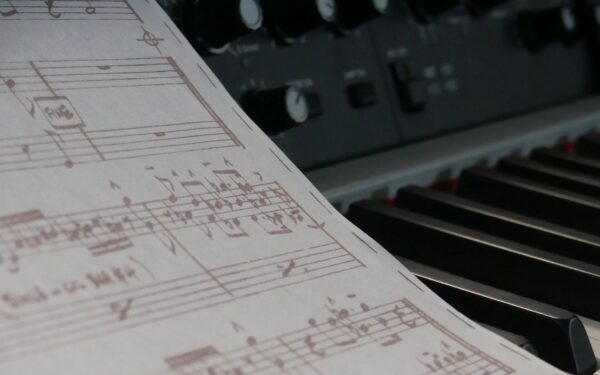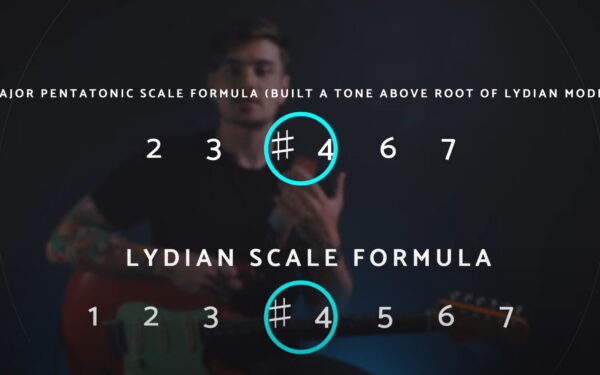Pentatonic Scales and Modes
Introduction
Tired of playing always the same patterns on the same scales in your improvisations? This article relates an experiment using modes in order to renew those good old pentatonic scales and give them unusual colors. Several approaches are discussed here:
- Add some notes to a pentatonic scale to give it the color of a mode.
- Modify the pentatonic scale notes in order to generate new pentatonic scales with specific modes colors.
Prerequisites
Basics of harmony, scales, modes and intervals are recommended.
Pentatonic scale harmonic structure
Let’s start by having a look at the classic pentatonic scales that we use in modern occidental music (many other pentatonic scales exist). We will use as an example the A minor scale, corresponding in terms of notes to the C major scale:
A Minor Pentatonic |
C Major Pentatonic |
| Notes: 1, 3, 4, 5, 7 | Notes: 1, 2, 3, 5, 6 |
| Chord: Am7 11 (or sus4) | Chord: C9 13 (or 9, 6) |
| Intervals: 3m, 4, 5, 7 | Intervals: 2, 3M, 5, 6 |
Applying modes to Pentatonic scales
Applying modes to those scales is simple: you can either add notes to the scale (which won’t be pentatonic anymore), when they are not part of the harmonic structure of the scale, or modify the existing intervals so that they fit into the chosen mode. This operation can be done on both minor and major pentatonic scales.
Minor Pentatonic modified by modes
Major Pentatonic modified by modes
Combined Scales
If we bring all these scales to the same tonic (let’s say A), this gives us a bunch of new pentatonic or extended pentatonic (hexaphonic) scales to experiment with:
In order to name these scales, we will use the combination of the mode and origin scale: for example, the first scale of the table above (upper-left) will be “Lydian-Minor Pentatonic” and the last one “Locrian-Major Pentatonic”, even if major and minor terms do not qualify the color of the corresponding scales. This is just a naming convention.
How does it sound?
Not all these scales will sound easy to your ears, but as a beginning you can try the ones which are not too far from the standard pentatonic scales, but which still have a very specific color. As an example:
- Myxolydyan-Minor Pentatonic: typical myxolydian sounding and very close to the minor pentatonic, very useful on seventh chords because of its major third. (try this E scale on E7!)
- Dorian-Major Pentatonic: minor by its third, but major by its sixth, very interesting color of the dorian mode. It sounds not that usual to our ears because of its major pentatonic origin.
- Dorian-Minor Pentatonic: extended minor pentatonic scale with the sixth, it has been used quite a lot by many musicians.
The strangest sounding one might be the Lydian-Minor scale, but it is very interesting to try it to add new colors to your solos.
How to use them?
Their usage is the same as modes, since this is how we generated them. But as their harmonic structure is simpler (some notes are missing), they might be used more often, in multiple contexts. Further more, we have two options on each mode, since we have two different sounding scales for the same mode.
First, you can try to play them with only the tonic as a pedal tone, as you would do with modes. This will help you to learn and appreciate the color of each scale.
The first step for playing them is then to use the scale corresponding to the chord being played. You can see that each scale has specific notes that qualify the mode from which it comes (see intervals row in the tables above). For example play E Myxolydyan-Minor Pentatonic on E7 chord, Phrygian-Major on E9b chord etc.
Then you might want to perform a broader analysis of the harmony of the song, and choose a scale depending on the chord progression: a typical example is to play the E dorian mode (especially the Dorian-Minor extended pentatonic) on a Em7 / A7 progression. The C# note will be great to announce the major third of the A7 chord.
Then any idea is welcome: practice and experiment with each scale and have fun!





















One thought on “Pentatonic Scales and Modes”